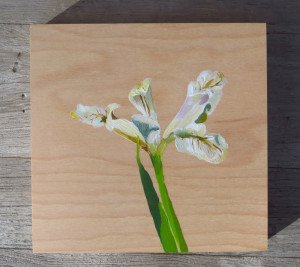I don’t have a lot of rules for myself when I am painting. But, I do have on cardinal rule: Never out of the tube!
What does this mean? I mix all my colors before they touch my canvas. Why?… well, there are a few reasons.
- Honestly, the number one reason I’d have to say is ego. Someone once said (in art school) “hey, you sure use a lot of sap green out of the tube.” I was pretty embarrassed. They had a name for my tree color? Not cool. I want them to see a tree, not a paint label.
- I want to pick my colors. When they come out of the tube the paint company is picking my color. I am probably choosing that color because it is simply there, looking at me from my box of paint or palette. Yes, I hear myself say “But blah-blah color is just the right color I need!” And, I mix it anyway. I have never been disappointed that I didn’t use it straight from the tube.
- Color theory! Ever mix a bunch of gray or browns? After a while you can tell what kind they are. Yellow/purple, red/green, or blue/orange. Then after a while you can tell what kind of each color went in. Was it Cadmium Red or Alizarin Crimson? If you are working with a limited palette and then you reach over and put some other random color in, it sticks out like a sore thumb.
- Zen. Some people meditate. Some people run. I mix paint. The little tap tap tap of the palette knife. Adding colors, blending, add, blend. Figuring out how to move a color one way or the other. Bliss. I am so in love with mixing paint. It is magical.
- Happy Accidents. Mixing paint teaches you about color. Even when you’ve done it for years.
- Limiting or expanding a palette. I used to have a second rule. It was “no phthalo.” I saw it take over one to many paintings at college critiques and so I straight up excommunicated it from my palette. I did still have a tube of it. One day, exasperated that my painting colors were off, I packed up all my tubes and headed out to the forest, sat down with a big piece of paper and started trying to mix the color of Redwood Sorrel. I sat in a forest trying everything I could think of, mixing and then holding up palette knife next to plant. Mix some more. And yep, I needed phthalo. So I welcomed him back. But cautiously. That dude is strong. Gamblin does a color every year called “torrit” gray which is made by taking out all the pigment from the factory air filters.
“The mix of pigments is different every year, so Torrit Grey is always unique and will never be repeated. Torrit Grey tends to have a greenish tinge because of the great strength of the Phthalo Green pigment, which is a dark bluish green.” –http://www.gamblincolors.com/torrit.grey/index.html
Having this break from phtalo green and blue was a wise choice for me. It was so strong that I really didn’t mix my other colors as well as I could have – it just took over. Adding it back in has been a wise choice. Now that I was ready it adds to my paintings instead of sticking out. I know some people have trouble with Cadmium Red and Cadmium Yellow, which are just so hot and opaque. Limiting and expanding a palette are a great way to learn a lot about color, but you won’t learn about them nearly as fast using them directly as you will mixing with them. If there is a color you have trouble with, kick it off your palette for a while. Did you need it? Did it behave better when you invited it back?
- Recognizable paintings. I want people to be able to recognize my paintings. To tell them apart from someone else. The more I can make each part of painting my own the better. We all mix paint a bit differently.
- Cheaper. Oh my goodness I would never be able to afford every color I want to use! Plus, who wants to locate that many different tubes while in the middle of a painting?
- Black & White – While I used to think that black and white are a possible exception to the rule, I have since decided for my work, they aren’t. I do realistic paintings. White, is not often found straight in nature. The color of sunlight has a yellow tint to it for example. The black maybe is really a deep brown. When I have broken this rule I have wished I didn’t. Try it for yourself! What works for you?
In this painting of a local wild iris I painted a nearly white iris using no-straight from the tube white at all. This painting was also done with an extremely limited palette of four tubes: zinc white, cadmium yellow medium, phthalo green (yellow shade) and dioxazine purple.

